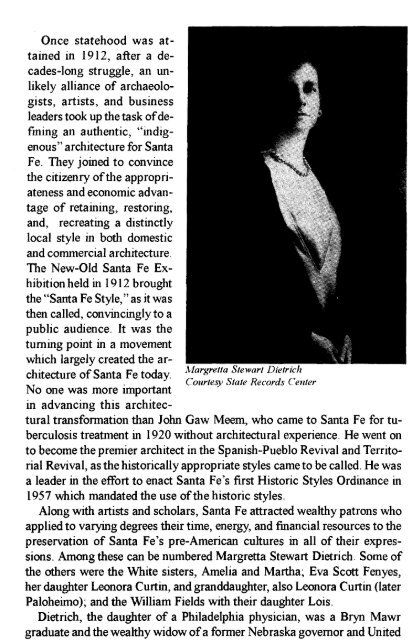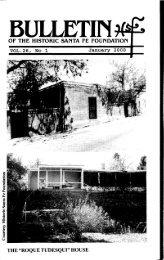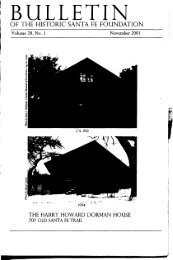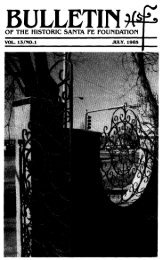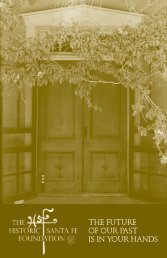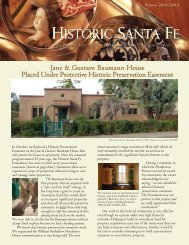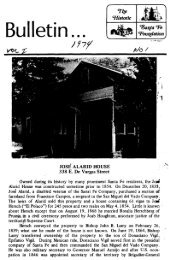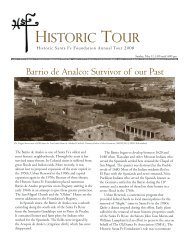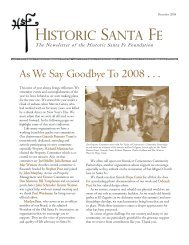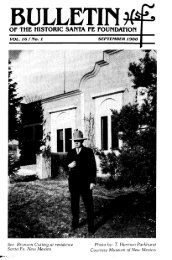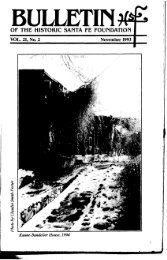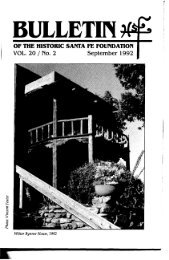James L. Johnson House - Historic Santa Fe Foundation
James L. Johnson House - Historic Santa Fe Foundation
James L. Johnson House - Historic Santa Fe Foundation
Create successful ePaper yourself
Turn your PDF publications into a flip-book with our unique Google optimized e-Paper software.
Once statehood was attained<br />
in 1912, after a decades-long<br />
struggle, an unlikely<br />
alliance of archaeologists,<br />
artists, and business<br />
leaders took up the task of defming<br />
an authentic, "indigenous"<br />
architecture for <strong>Santa</strong><br />
<strong>Fe</strong>. They joined to convince<br />
the citizenry of the appropriateness<br />
and economic advantage<br />
of retaining, restoring,<br />
and, recreating a distinctly<br />
local style in both domestic<br />
and commercial architecture.<br />
The New-Old <strong>Santa</strong> <strong>Fe</strong> Exhibition<br />
held in 1912 brought<br />
the "<strong>Santa</strong> <strong>Fe</strong> Style," as it was<br />
then called, convincingly to a<br />
public audience. It was the<br />
turning point in a movement<br />
which largely created the architecture<br />
of <strong>Santa</strong> <strong>Fe</strong> today. A,fargretla Stewart Die1ri~h<br />
N . Courtesy State Records Center<br />
o one was more Important .<br />
in advancing this architectural<br />
transformation than John Gaw Meem, who came to <strong>Santa</strong> <strong>Fe</strong> for tuberculosis<br />
treatment in 1920 without architectural experience. He went on<br />
to become the premier architect in the Spanish-Pueblo Revival and Territorial<br />
Revival, as the historically appropriate styles came to be called. He was<br />
a leader in the effort to enact <strong>Santa</strong> <strong>Fe</strong>'s first <strong>Historic</strong> Styles Ordinance in<br />
1957 which mandated the use of the historic styles.<br />
Along with artists and scholars, <strong>Santa</strong> <strong>Fe</strong> attracted wealthy patrons who<br />
applied to varying degrees their time, energy, and financial resources to the<br />
preservation of <strong>Santa</strong> <strong>Fe</strong>'s pre-American cultures in all of their expressions.<br />
Among these can be numbered Margretta Stewart Dietrich. Some of<br />
the others were the White sisters, Amelia and Martha; Eva Scott <strong>Fe</strong>nyes,<br />
her daughter Leonora Curtin, and granddaughter, also Leonora Curtin (later<br />
Paloheimo); and the William Fields with their daughter Lois.<br />
Dietrich, the daughter of a Philadelphia physician, was a Bryn Mawr<br />
graduate and the wealthy widow of a former Nebraska governor and United


